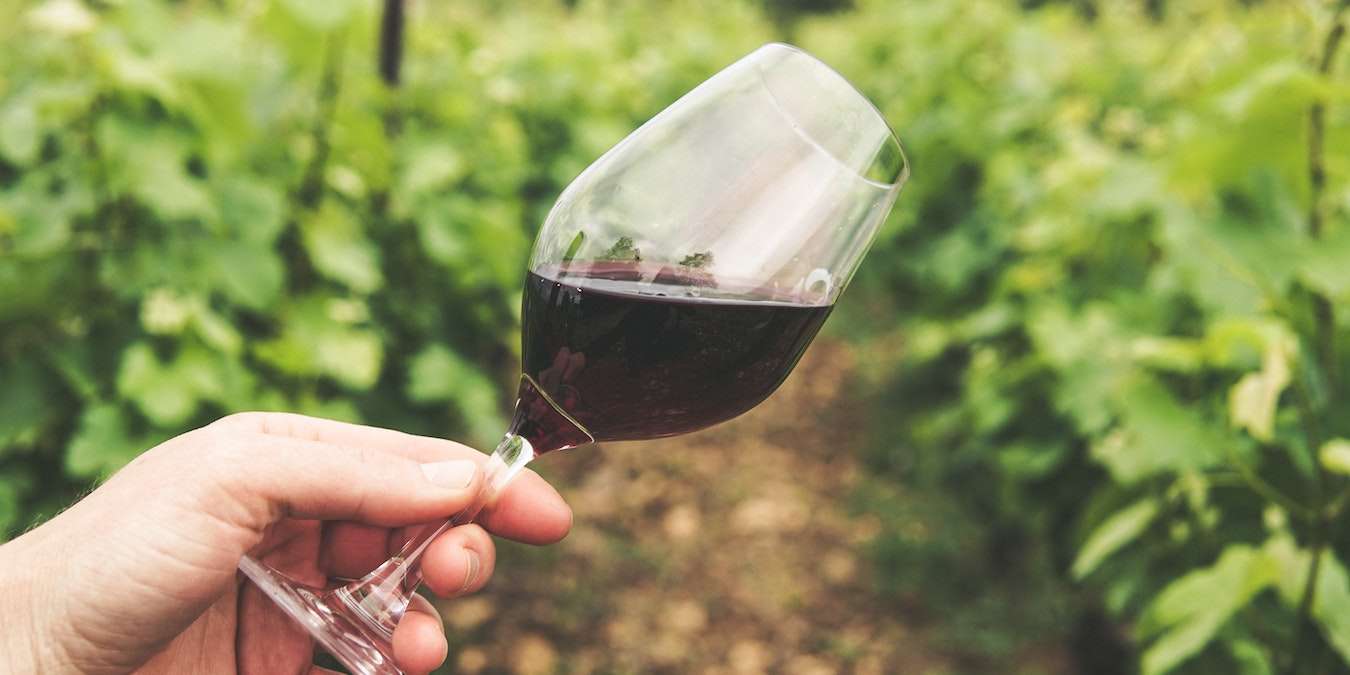
Wine has been an integral part of human culture for thousands of years. The diverse range of flavors, aromas, and characteristics of different types of wine make them a delight for enthusiasts and connoisseurs alike. From robust reds to crisp whites, sparkling celebratory wines to luscious dessert wines, each category offers a unique experience.
Before you go buying bottles of wine in-store or shop for wine online, you need to fully understand the different varieties of wine that are available. We’ve broken down the distinguishing characteristics of each type of wine and included some popular blends in each category.
1. Red Wine
Red wine gets its name from the color of the grapes that produce it. The color of red wine comes from the pigments in the skins of these red or black grapes.

During the winemaking process of red wine, the grape juice contacts the grape skins, which contain pigments called anthocyanins. These anthocyanins are responsible for the red color of the wine. The longer the grape skins remain in contact with the juice during fermentation, the deeper the color of the resulting red wine.
After fermentation, makers separate the wine from the skins. Then, further aging and refinement may occur in vessels like barrels or tanks. This aging process can impart additional flavors and characteristics to red wine, leading to various tastes, aromas, and textures.
Characteristics and Flavor
Each red wine has unique attributes based on the grape variety, the region where it’s grown, the winemaking techniques, and its age. However, you can summarize red wine flavors by the presence of these traits: fruit, floral aromas, herbs/pepper/spice, earthiness, leather, and vanilla.
Examples of Red Wines
- Cabernet Sauvignon: Known for its boldness and complexity, Cabernet Sauvignon is often referred to as the “king” of red wines. It typically features flavors of blackcurrant, plum, and sometimes hints of tobacco or cedar.
- Merlot: A more approachable red wine, Merlot is known for its smooth and soft texture, with flavors of ripe red fruits like cherry, raspberry, and plum.
- Pinot Noir: Often described as elegant and delicate, Pinot Noir is renowned for its red fruit flavors such as cherry, strawberry, and cranberry, with subtle earthy undertones.
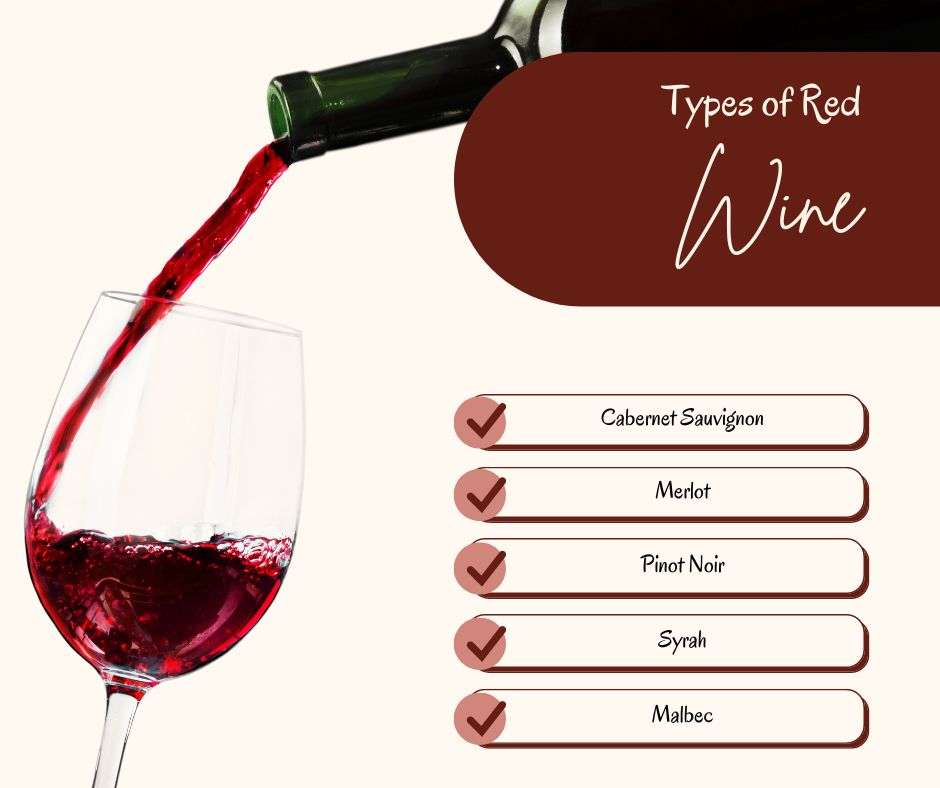
2. White Wine
White wine appears pale or straw-like in color, resembling the color of white grapes. However, the distinction between white and red wines is not solely based on the color of the grapes used. Instead, it primarily depends on the winemaking process and the grape varieties.

Unlike other types of wine, white wines do not undergo prolonged contact between the grape juice and the skins. The winemaking process for white wine involves quickly separating the grape juice from the skins to minimize color extraction. This results in a wine with a light or clear appearance.
Characteristics and Flavor
White wines typically have a wide range of flavors and aromas, often showcasing fruit notes such as citrus (lemon, lime, grapefruit), apple, pear, peach, tropical fruits, and floral elements. Additionally, certain white wines may exhibit herbal or mineral characteristics, depending on the grape variety and the region where the grapes are grown.
Examples of White Wines
- Chardonnay: Known for its versatility, Chardonnay offers a wide range of flavors based on the region and winemaking style. Common notes include apple, citrus, tropical fruits, and vanilla.
- Sauvignon Blanc: Crisp and refreshing, Sauvignon Blanc often presents citrus flavors, along with herbaceous notes like grass or bell pepper.
- Riesling: Offering a beautiful balance of sweetness and acidity, Riesling displays flavors of green apple, peach, and floral undertones.
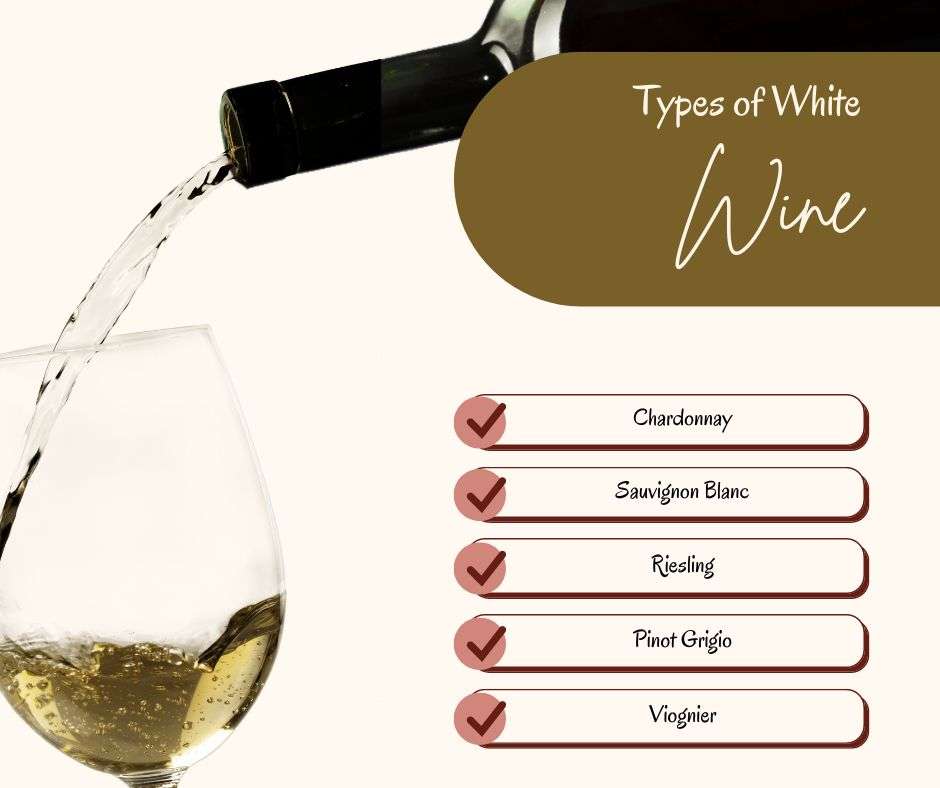
3. Rosé Wine
Rosé wine, often referred to simply as rosé, falls between the categories of red and white wines in terms of color and style. The winemaking process distinguishes rosé wine from other types of wine, which involves specific techniques to achieve its characteristic pink color and flavor profile.

The winemaking process for rosé involves limited contact between the grape juice and the grape skins compared to red wine production. After growers harvest the grapes, they crush them. Then, the juice macerates with the skins for a short period, typically a few hours to a couple of days. This short maceration period imparts a subtle pink hue to the wine, as the pigments from the skins are extracted into the juice. The duration of skin contact directly influences the intensity of the color.
Characteristics and Flavor
Rosé wines offer a wide range of flavors and aromas, often showcasing fruit notes such as strawberry, raspberry, cherry, watermelon, and citrus fruits. Depending on the grape variety and the winemaking process, rosé wines can range from bone-dry to slightly sweet, with a refreshing acidity that makes them particularly enjoyable on warm days.
Examples of Rosé
- Provence Rosé: Originating from the Provence region in France, this pale and elegant rosé offers delicate flavors of strawberry, melon, and citrus.
- White Zinfandel: A popular and slightly sweeter style, White Zinfandel showcases flavors of ripe red berries and often has a refreshing, off-dry taste.
- Spanish Rosado: Spanish rosé wines, known as Rosado, often feature berry and watermelon notes with a vibrant pink hue.
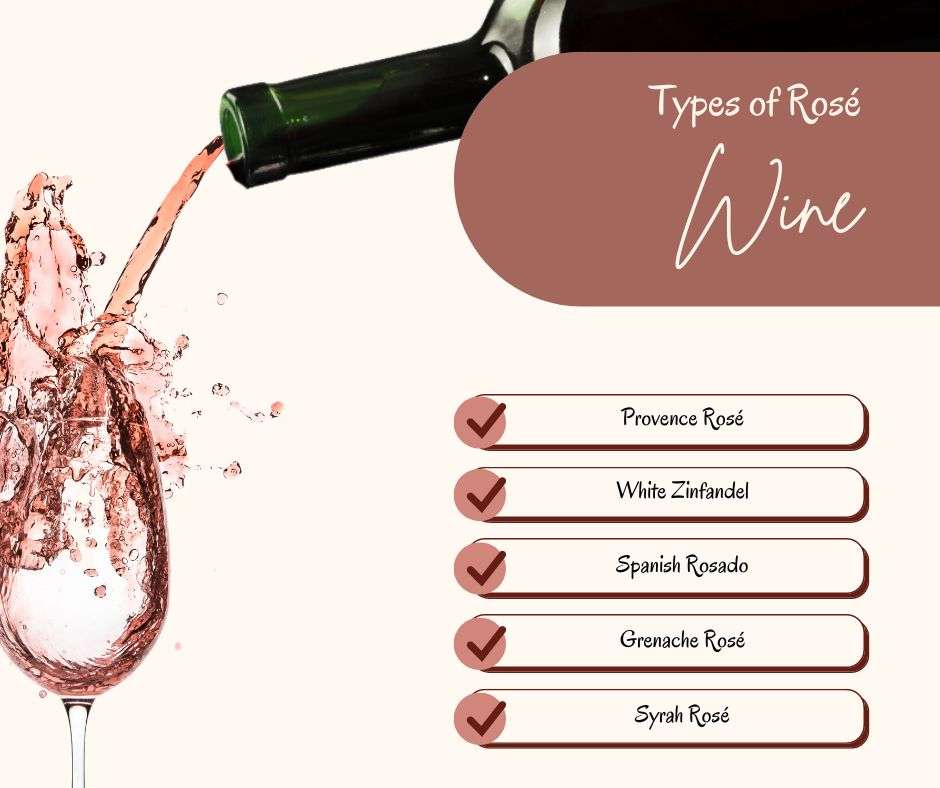
4. Sparkling Wines
Sparkling wine is a type of wine that is distinguished by the presence of bubbles in the wine. Carbon dioxide creates bubbles, and it forms during fermentation. Specific methods of producing sparkling wine set it apart from still (non-effervescent) wines.

The primary characteristic that defines sparkling wine from other types of wine is the process of secondary fermentation. After the initial fermentation, where grape juice transforms into alcohol, a second fermentation occurs. This secondary fermentation creates the bubbles and uses one of two main methods: the Traditional Method (also known as the Champagne Method) and the Tank Method (also known as the Charmat Method).
Characteristics and Flavor
Sparkling wine can be made from various grape varieties, including Chardonnay, Pinot Noir, Pinot Meunier, Chenin Blanc, Prosecco (Glera), and others. The flavors in sparkling wines can vary based on the grapes used, and the wine can also range from dry to sweet, depending on the level of residual sugar present in the wine.
However, the defining characteristic of sparkling wine is the presence of bubbles, which can vary in size and intensity. The bubbles contribute to the wine’s lively and effervescent nature, creating a delightful drinking experience.
Examples of Sparkling Wine
- Champagne: Produced exclusively in the Champagne region of France, Champagne is the epitome of celebration and luxury. It features lively bubbles and complex flavors of apple, brioche, and toasty notes.
- Prosecco: Originating from Italy, Prosecco is typically fruitier and more floral than Champagne, with flavors of pear, green apple, and honey.
- Cava: Hailing from Spain, Cava is known for its excellent value and often exhibits citrus and almond notes.
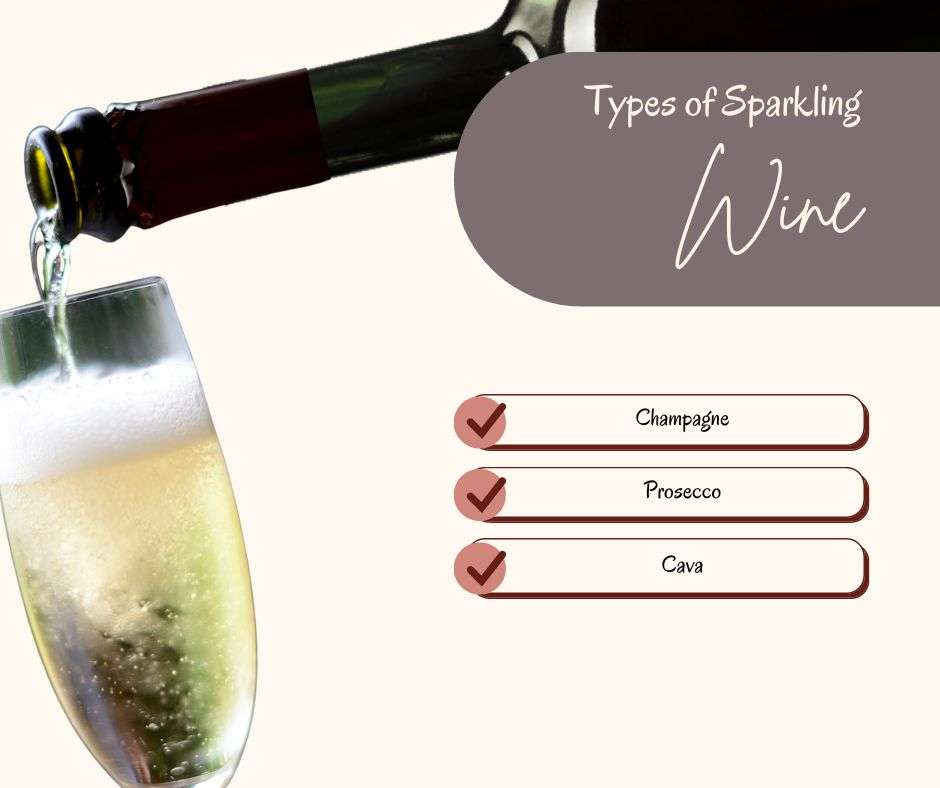
5. Dessert Wines
Dessert wine, also known as sweet wine, is a type of wine that is specifically made to be sweeter in taste and is often enjoyed as a dessert accompaniment. These wines are distinct from dry wines (non-sweet wines) due to their higher sugar content, which results from several factors in the winemaking process.

Dessert wines use grapes that stay on the vine for an extended period, well beyond regular harvest times. This extended hang time allows the grapes to accumulate higher sugar levels, as the grapes continue to ripen and develop their sweetness.
Characteristics and Flavor
Dessert wines come in various levels of sweetness, ranging from off-dry (slightly sweet) to lusciously sweet. The sweetness level is often indicated on the label or described by terms such as “dry,” “semi-sweet,” “sweet,” or “very sweet.”
Examples of Dessert Wine
- Port: A fortified wine from Portugal, Port offers rich and sweet flavors of dark fruits, chocolate, and spices.
- Sauternes: Produced in the Sauternes region of France, this sweet wine boasts flavors of honey, apricot, and peach, often with a luscious, viscous texture.
- Ice Wine: Made from grapes that have frozen on the vine, Ice Wine delivers intense sweetness, with flavors of candied fruits and honey.
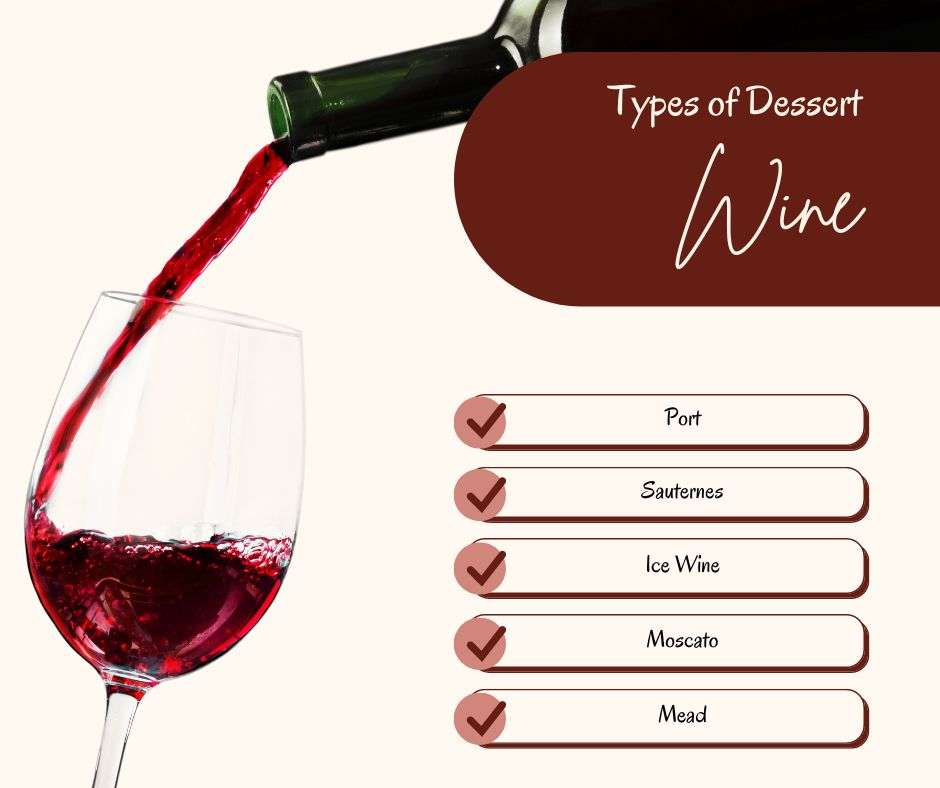
Explore All Types of Wine
The world of wine is vast and diverse, offering something for every palate. Whether you prefer the robustness of reds, the freshness of whites, the elegance of rosé, the effervescence of sparkling wines, or the sweetness of dessert wines, each of these types of wine has its unique charm and appeal. To truly appreciate the beauty of wine, experiment with different blends, store them correctly, and savor them alongside complementary dishes. Cheers to the world of wine and the delightful journey it takes us on!
Also, if you are new to wine, our guide to wine for newbies can help.
Image credit: Pexels











